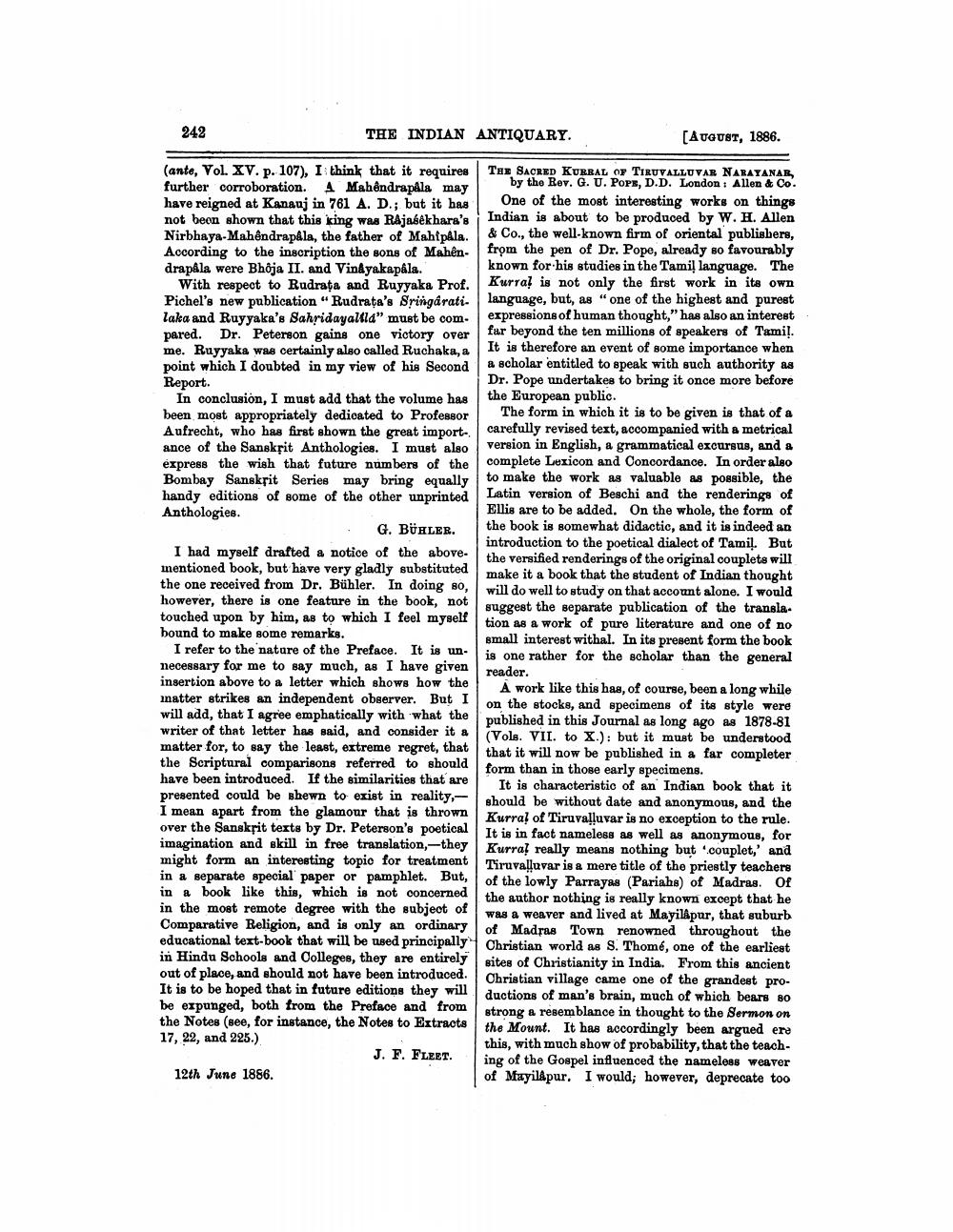________________
242
THE INDIAN ANTIQUARY.
[AUGUST, 1886.
(ante, Vol. XV. p. 107), I think that it requires THE SACRED KURRAL OF TIRUVALLUVAR NARAYANAR, further corroboration. A Mahêndrapla may
by the Rev. G. U. POPE, D.D. London: Allen & Co. have reigned at Kananj in 761 A. D.; but it has
One of the most interesting works on things not beon shown that this king was Rajasekhara's Indian is about to be produced by W. H. Allen Nirbhaya-Mahendrapala, the father of Mahipala. & Co., the well-known firm of oriental publishers, According to the inscription the sons of Mahen- from the pen of Dr. Pope, already so favourably drapala were Bhöja II. and Vinayakapala.
known for his studies in the Tamil language. The With respect to Radrata and Ruyyaka Prof. Kurra! is not only the first work in its own Pichel's new publication “Rudrata's Sringarati language, but, as "one of the highest and purest laka and Ruyyaka's Sahridayallla" must be com.
expressions of human thought," has also an interest pared. Dr. Peterson gains one victory over far beyond the ten millions of speakers of Tamil. me. Ruyyaka was certainly also called Ruchaka, a It is therefore an event of some importance when point which I doubted in my view of his Second a scholar entitled to speak with such authority as Report.
Dr. Pope undertakes to bring it once more before In conclusion, I must add that the volume has
the European public. been most appropriately dedicated to Professor
The form in which it is to be given is that of a Aufrecht, who has first shown the great import..
carefully revised text, accompanied with a metrical ance of the Sanskrit Anthologies. I must also
version in English, a grammatical excursus, and a express the wish that future numbers of the complete Lexicon and Concordance. In order also Bombay Sanskrit Series may bring equally
to make the work as valuable as possible, the handy editions of some of the other unprinted
Latin version of Beschi and the renderings of Anthologies.
Ellis are to be added. On the whole, the form of G. BÜHLER. the book is somewhat didactic, and it is indeed an
introduction to the poetical dialect of Tamil. But I had myself drafted a notice of the above.
the versified renderings of the original couplets will mentioned book, but have very gladly substituted
make it a book that the student of Indian thought the one received from Dr. Bühler. In doing so, will do well to study on that account alone. I would however, there is one feature in the book, not
suggest the separate publication of the translatouched upon by him, as to which I feel myself
tion as a work of pure literature and one of no bound to make some remarks.
small interest withal. In its present form the book I refer to the nature of the Preface. It is un
is one rather for the scholar than the general necessary for me to say much, as I have given
reader. insertion above to a letter which shows how the
A work like this has, of course, been a long while inatter strikes an independent observer. But I
on the stocks, and specimens of its style were will add, that I agree emphatically with what the
published in this Journal as long ago as 1878-81 writer of that letter has said, and consider it a
(Vols. VII. to X.): but it must be understood matter for, to say the least, extreme regret, that
that it will now be published in a far completer the Scriptural comparisons referred to should
form than in those early specimens. have been introduced. If the similarities that are
It is characteristic of an Indian book that it presented could be shewn to exist in reality,
should be without date and anonymous, and the I mean apart from the glamour that is thrown
Kurral of Tiruvalluvar is no exception to the rule. over the Sanskrit texts by Dr. Peterson's poetical It is in fact nam
It is in fact nameless as well as anonymous, for imagination and skill in free translation, they | Kurral really means nothing but 'couplet, and might form an interesting topio for treatment Tiruvalluvar is a mere title of the priestly teachers in a separate special paper or pamphlet. But,
of the lowly Parrayas (Pariahs) of Madras. Of in a book like this, which is not concerned
the author nothing is really known except that he in the most remote degree with the subject of
was a weaver and lived at MayilApur, that suburb Comparative Religion, and is only an ordinary of Madras Town renowned throughout the educational text-book that will be used principally Christian world as S. Thomé, one of the earliest in Hindu Schools and Colleges, they are entirely l rites of Christianity in India. From this ancient out of place, and should not have been introduced. Christian village came one of the grandeat pro. It is to be hoped that in future editions they will ductions of man's brain, much of which bears 60 be expunged, both from the Preface and from
strong a resemblance in thought to the Sermon on the Notes (nee, for instance, the Notes to Extracts |
the Mount. It has accordingly been argued era 17, 22, and 225.)
this, with much show of probability, that the teachJ. F. FLEET.
ing of the Gospel influenced the nameless weaver 12th June 1886.
of MayilApur. I would; however, deprecate too




